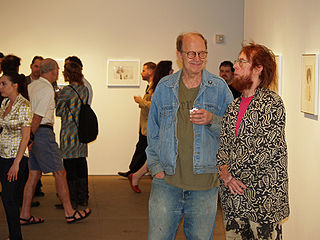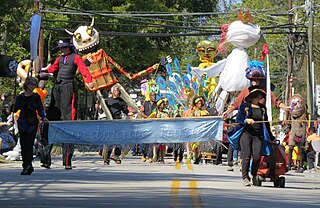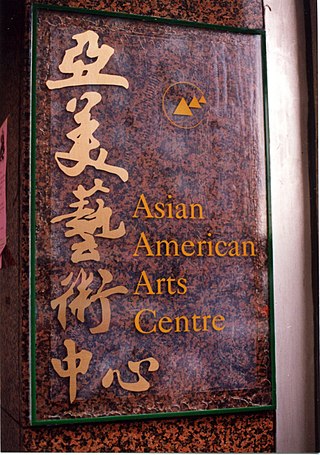
An art museum or art gallery is a building or space for the display of art, usually from the museum's own collection. It might be in public or private ownership, be accessible to all, or have restrictions in place. Although primarily concerned with visual art, art museums are often used as a venue for other cultural exchanges and artistic activities, such as lectures, jewelry, performance arts, music concerts, or poetry readings. Art museums also frequently host themed temporary exhibitions, which often include items on loan from other collections.

Art in General was a non-profit contemporary art exhibition space known for its vibrant and ground-breaking projects as a formidable and longstanding New York City alternative space, focused on giving meaningful resources and opportunities to artists early on in their careers. Founded in 1981 by artists Martin Weinstein and Teresa Liszka and originally located in the General Hardware building in New York City — hence the organization's name, Art in General — the institution produced and presented distinctive programs and exhibitions featuring new work by local and international artists.

The Canadian Clay and Glass Gallery (CCGG) is a public art gallery located in Waterloo, Ontario, Canada. It is the only Canadian art gallery exclusively dedicated to exhibiting and collecting contemporary Canadian ceramic, glass, enamel and stained glass works of art. It has approximately 20,000 annual visitors.
Community art, also known as social art, community-engaged art, community-based art, and, rarely, dialogical art, is the practice of art based in and generated in a community setting. It is closely related to social practice and social turn. Works in this form can be of any media and are characterized by interaction or dialogue with the community. Professional artists may collaborate with communities which may not normally engage in the arts. The term was defined in the late 1960s as the practice grew in the United States, Canada, the Netherlands, the United Kingdom, Ireland, and Australia. In Scandinavia, the term "community art" more often refers to contemporary art projects.

An artist-run space or artist-run centre (Canada) is a gallery or other facility operated or directed by artists, frequently circumventing the structures of public art centers, museums, or commercial galleries and allowing for a more experimental program. An artist-run initiative (ARI) is any project run by artists, including sound or visual artists, to present their and others' projects. They might approximate a traditional art gallery space in appearance or function, or they may take a markedly different approach, limited only by the artist's understanding of the term. "Artist-run initiatives" is an umbrella name for many types of artist-generated activity.

An art dealer is a person or company that buys and sells works of art, or acts as the intermediary between the buyers and sellers of art.

A contemporary art gallery is normally a commercial art gallery operated by an art dealer which specializes in displaying for sale contemporary art, usually new works of art by living artists. This approach has been called the "Castelli Method" after Leo Castelli, whose success was attributed to his active involvement in discovering and promoting emerging artists beginning in the late 1950s with Jasper Johns and Robert Rauschenberg.
Arts administration is a field in the arts sector that facilitates programming within cultural organizations. Arts administrators are responsible for facilitating the day-to-day operations of the organization as well as the long term goals by and fulfilling its vision, mission and mandate. Arts management became present in the arts and culture sector in the 1960s. Organizations include professional non-profit entities. For examples theaters, museums, symphony orchestras, concert bands, jazz organizations, opera houses, ballet companies and many smaller professional and non-professional for-profit arts-related organizations. The duties of an arts administrator can include staff management, marketing, budget management, public relations, fundraising, program development evaluation, community engagement, strategic planning, and board relations.
Canadian artist-run centres are galleries and art spaces developed by artists in Canada since the 1960s. Artist-run centre is the common term of use for artist-initiated and managed organizations in Canada. Most centres follow the not-for-profit arts organization model, do not charge admission fees, pay artists for their contributions are non-commercial and de-emphasize the selling of artwork.

The Hillsborough Arts Council is the official Hillsborough, NC Arts Council endorsed by The Town of Hillsborough, NC, the Hillsborough Chamber of Commerce and The North Carolina Arts Council. The Council is incorporated in the state of North Carolina as a 501(c)(3) non-profit organization. Located in Hillsborough, North Carolina the council is a mostly volunteer organization whose primary role is to support the arts and enrich the community through education and by organizing events that feature local artists.

The Asian American Arts Centre (AAAC) is a non-profit organization located in the Chinatown neighborhood of Manhattan in New York City. Founded in 1974, it's one of the earliest Asian American community organizations in the United States. The Arts Centre presents the ongoing developments between contemporary Asian & Asian American art forms and Western art forms through the presentation of performance, exhibitions, and public education. AAAC's permanent collection, which it has accumulated since 1989, contains hundreds of contemporary Asian American art works and traditional/folk art pieces. The organization also has an Artists Archive which documents, preserves, and promotes the presence of Asian American visual culture in the United States since 1945. This includes the East Coast, especially the greater New York area; the West Coast; and some artists in Canada, Hawaii, and overseas. The artists include Asian Americans producing art, Asian artists who are active in the United States, and other Americans who are significantly influenced by Asia. Pan-Asian in outlook, the Arts Centre's understanding of 'Asia' encompasses traditions and influences with sources ranging from Afghanistan to Hawaii.
The Galeries Ontario / Ontario Galleries (GOG), formerly Ontario Association of Art Galleries / Association Ontarienne des Galeries d’Art (OAAG/AOGA), was established in 1968 to encourage development of public art galleries, art museums, community galleries and related visual arts organizations in Ontario, Canada. It was incorporated in Ontario in 1970, and registered as a charitable organization. It is a successor organization to the Southern Ontario Gallery Group founded in 1947, renamed the Art Institute of Ontario in 1952. In December of 2020 Ontario Association of Art Galleries / Association Ontarienne des Galeries d’Art (OAAG/AOGA) rebranded to the name Galeries Ontario / Ontario Galleries (GOG) which included new brand identity, logo, and website to better serve art organizations in Ontario and Canada.

The Contemporary Art Gallery (CAG) is a non-profit public contemporary art gallery in downtown Vancouver. The CAG exhibits local, national, and international artists, primarily featuring emerging local artists producing Canadian contemporary art. It has exhibited work by many of Vancouver's most acclaimed artists, including Stan Douglas, Ian Wallace, Rodney Graham, Liz Magor, and Brian Jungen, and it continues to feature local artists such as Damian Moppett, Shannon Oksanen, Elspeth Pratt, Myfanwy MacLeod, Krista Belle Stewart and many others. International artists who have had exhibitions at the CAG include Dan Graham, Christopher Williams, Rachel Harrison, Hans-Peter Feldmann and Ceal Floyer. Other notable people that have curated or written for the CAG include Douglas Coupland, Beatriz Colomina, Roy Arden, and John Welchman. The gallery offers free admission to all visitors.

The New Gallery (TNG) is a non-commercial artist-run centre that presents and promotes contemporary art in Calgary, Alberta, Canada.

The Art Gallery of Guelph (AGG), formerly the Macdonald Stewart Art Centre (MSAC), is a public gallery and adjoining sculpture park in Guelph, Ontario. Its collection consists of over 9,000 works. The AGG is a nonprofit that focuses on research, publishing, educational programs, and touring exhibitions.
Foundation for Art Resources (FAR) is a Los Angeles-based, non-profit arts organization that facilitates the production and presentation of contemporary art projects outside of the gallery structure. It was founded in 1977 by gallerists Morgan Thomas, Connie Lewallen, and Claire Copley, who transferred leadership to the artist and mediator Dorit Cypis in 1979. Since then, FAR has been overseen collaboratively by over 20 different groups of Board Members and 100 artist-Directors. Currently the longest-running extant arts collective in Los Angeles with no exhibition space, FAR partners with different private, public and educational institutions throughout Los Angeles to produce exhibitions, lectures, and performances with a focus on the relational structures between art, producers, and audience.
Working Artists and the Greater Economy (W.A.G.E.) is a New York-based activist group and non-profit organization whose stated advocacy mission is "to establish sustainable economic relationships between artists and the institutions that contract our labor, and to introduce mechanisms for self-regulation into the art field that collectively bring about a more equitable distribution of its economy".
Âhasiw Maskêgon-Iskwêw (1958–2006) was a Cree and French Métis theorist, curator and artist. Maskêgon-Iskwêw was a significant figure in the field of contemporary Indigenous arts, and a formative proponent of digital media within Indigenous communities. In their 2015 book dedication to him, Steven Loft and Kerry Swanson describe Maskêgon-Iskwêw as "one of the foremost thinkers and practitioners of Aboriginal new media art."

An art gallery is a room or a building in which visual art is displayed. In Western cultures from the mid-15th century, a gallery was any long, narrow covered passage along a wall, first used in the sense of a place for art in the 1590s. The long gallery in Elizabethan and Jacobean houses served many purposes including the display of art. Historically, art is displayed as evidence of status and wealth, and for religious art as objects of ritual or the depiction of narratives. The first galleries were in the palaces of the aristocracy, or in churches. As art collections grew, buildings became dedicated to art, becoming the first art museums.
Arts of Life, based in Chicago, is a 501(c)3 nonprofit organization that provides studio space, supplies, professional development support, and exhibition opportunities to artists with intellectual and developmental disabilities. At the time of its founding in 2000, Arts of Life was the first program in Chicago to provide employment in the arts for adults with developmental disabilities. It has two studio and gallery locations that are each 6,000 square feet. The Chicago studio is located at 2010 West Carroll Avenue, in Chicago, Illinois and the North Shore studio is located at 1963 Johns Drive in Glenview, Illinois. The studio's artists work in various media, including painting, drawing, fibers, sculpture, music, and performance. As of 2021, the studio supports and provides services for over 60 artists.











